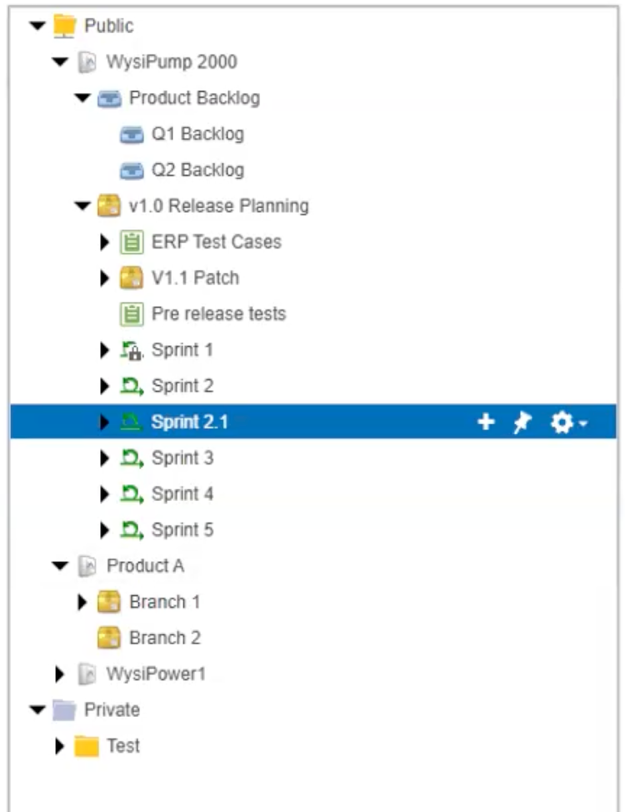Blog
May 5, 2025
Agile Requirements Gathering: Practical Advice to Improve Traceability
Application Lifecycle Management,
Security & Compliance,
Software Quality
Gathering requirements in an Agile environment can feel like a balancing act, especially if you're operating in a heavily regulated industry. While the collaborative and iterative nature of an Agile approach facilitates productive and efficient workflows, it can make gathering and tracking requirements difficult. In the rush to complete a sprint, it’s easy to lose sight of user stories and the corresponding acceptance criteria.
Three reasons Agile teams struggle with requirements gathering include:
- Difficulty agreeing on a process to follow.
- Navigating projects that aren’t always suited to Agile methodology, such as those that require a PRD (product requirements document).
- Meeting the Agile goal of reducing documentation while operating in a regulated industry.
If you struggle with requirement traceability in an Agile or hybrid environment, Perforce has solutions. It this article, we’ll discuss strategies for managing requirements while remaining Agile and how the right requirements management tool offers significant benefits.
Table of Contents
- How is Agile Requirements Gathering Different from Traditional (Waterfall)?
- Requirements Documentation in Agile vs Waterfall
- 5 Requirements Gathering Techniques in an Agile Environment
- The Benefits of a Requirements Management Tool
- Why Choose Perforce ALM for Agile Requirements Management?
- Simplify Requirements Gathering
>>> TRY PERFORCE ALM FOR HYBRID AGILE
Back to top
How is Agile Requirements Gathering Different from Traditional (Waterfall)?
Requirement gathering techniques vary depending on your development process. Each has its benefits and limitations:
Traditional
Traditional (Waterfall) project requirements are set early on during development. Teams exhaustively brainstorm and extensively document to ensure all necessary requirements are reviewed and approved before the design and production phases. Once approved, these requirements rarely change. Customer feedback does not usually inform requirements, and instead typically comes via bug fixes or added features. Additionally, the PRD clearly outlines what the requirements are without describing why they need to be met.
- Advantage: This linear approach with clear requirements provides teams with detailed direction and a sequential flow.
- Limitation: Difficulty addressing bugs or design changes once production begins.
Agile
Conversely, the Agile requirements gathering process is collaborative and iterative. Stakeholders review and update requirements throughout the development lifecycle. For instance, teams might begin by outlining why the requirements matter to the user or stakeholder and develop a user story around these needs. Through short feedback loops, the story evolves into the design and production phases. Even if the process isn’t purely Agile, it allows teams to embrace change as they go through requirement gathering steps.
- Advantage: This flexible approach allows teams to refine the product throughout its lifecycle and mitigate changes and challenges as they arise.
- Limitation: Tracking requirement changes through multiple iterations can be challenging and fatiguing.
Side-By-Side Features
Feature | Waterfall | Agile |
Requirements Phase | Fixed, upfront | Ongoing, iterative |
Flexibility | Low | High |
Stakeholder Involvement | Primarily in the beginning | Continuous |
Documentation | Extensive and formal | Light and evolving |
Adaptability | Limited | High |
Ideal Projects | Regulated or well-defined | Fast paced with uncertain scope |
Risk of Rework | High and costly | Low and preventative |
Compliance Suitability | Strong | Strong (with ALM tools) |
Back to top
Requirements Documentation in Agile vs Waterfall
User stories in an Agile release include the same elements found in a traditional PRD:
- Purpose
- Features
- Criteria
- Timeline
However, where the traditional PRD is a relatively static document, the Agile document is an interactive document that might live on a task board throughout the entire product lifecycle. It’s this cyclical and multi-stakeholder nature of Agile requirements that makes traceability trickier.
Common challenges include:
- Ensuring Compliance: Regulations often necessitate specific documentation, audits, and traceability, which can conflict with the limiting documentation principles in the Agile manifesto.
- Balancing Speed and Quality: Agile seeks to deliver value swiftly, but products must also meet the stringent quality and safety standards set out in your requirements.
- Stakeholder Alignment: Requirements need to align with internal teams, external auditors, and regulatory bodies, making stakeholder management more complex.
- Change Management: Operating in regulatory environments can make it difficult to adapt to the iterative changes inherent in Agile.
Hybrid Agile Documentation
For stringent requirements, you may need to follow a more traditional approach. An effective adaptation is to include links to static documents within user stories to define the strict parameters required to meet regulatory compliance. Using a requirements management tool that accommodates hybrid Agile environments, is the most efficient means of accomplishing this.
There are numerous ways to capture requirements Agilely. The information you gather still answers the basic outline of purpose, features, criteria, and timeline but the differences lie in the way you will document and use the information. It could also affect how you organize or prioritize the requirements (more on this later).
Before we dive into specific techniques for Agile requirements gathering, let’s review a short list of traditional requirements gathering techniques. Employing more than one of the approaches reduces the risk of overlooking crucial data:
- Brainstorming: Gather ideas, then organize and prioritize them with a facilitator (such as the product owner).
- Interviews or questionnaires: Engage stakeholders directly or with surveys to assess business needs and product solutions.
- Review similar systems: Examine documentation from existing systems for insights and a starting framework.
- Observe the target environment: Observe user interactions in the target environment to uncover requirements and improvement areas.
- Talk to support teams: Learn about common user challenges from support, training, and installation teams.
5 Requirements Gathering Techniques in an Agile Environment
Agile depends on input across silos to refine and gather requirements effectively and ensure that stakeholders remain aligned. Here are five common methods used:
1. Detail End-User Stories with Critical Links and Acceptance Criteria
If you operate in a regulated industry, you need to keep compliance information available without compromising the simplicity of the user story. In these cases, add links within the stories to pertinent documents. To add another level of detail, you can provide acceptance criteria in the user stories.
2. Workshop with Cross-Functional Teams
Conduct workshops that bring together developers, compliance officers, product owners, and subject matter experts. This ensures that diverse experts share a common understanding of regulatory priorities and product goals. Trust the product owner to prioritize the user requirements and maintain the backlog. You might use index cards, a Kanban board, or other proven Agile methodologies to keep your team on track.
3. Track Status and Communication with Stakeholders
Use Agile ceremonies like sprint demos and retrospectives to engage stakeholders. As you work through sprints and share updates with stakeholders, track their feedback. If traceability is critical for your team, use a tool that links comments to the user stories. Additionally, track your change history to demonstrate how requirements evolve and maintain accountability. Detailed records, status checks, and an immutable change history (who made what changes and when) ensures traceability and stakeholder alignment throughout the development lifecycle.
4. Build Prototypes
Teams don’t always know what they need until they see the result. Simple prototypes can help stakeholders visualize requirements and identify gaps early, giving clarity before proceeding into the next developmental sprint. Save time and costly reworks with a sneak peek.
5. Utilize a Requirements Management Tool
The right requirements management tool, like Perforce ALM, can save you countless regulatory and documentation headaches. This Application Lifecycle Management tool provides end-to-end traceability across your requirements, issues, and test cases, all within a single source of truth. It alleviates the need to maintain documentation in the anti-documentation world of Agile while sparing you from cumbersome manual templates. Plus, Perforce ALM’s dropdowns and pre-populated fields simplify building user stories for greater efficiency. Talk about agility!
Back to topEvaluating Requirements Management Solutions?
Learn the 5 questions to ask when comparing requirements management solutions. Our Requirements Management Software Buyer's Guide is a must-read for SMB teams looking to update their manual processes with an intuitive and fully traceable software platform. This is especially crucial for teams facing compliance issues in highly regulated industries.
The Benefits of a Requirements Management Tool
Using a spreadsheet or text doc as your Agile requirements document becomes inefficient and cumbersome quickly. As team members struggle to hunt down the most recent version, feedback becomes lost and important updates get overlooked. Most importantly, it becomes challenging, if not impossible, to prove compliance without clear traceability.
A requirements management tool solves these problems and empowers teams to perform sprints at an Agile cadence without losing valuable documentation. You’ll be able to avoid bottlenecks by quickly measuring important development KPIs such as:
- Cycle Time for Requirement Approval: Measure how long it takes to review and approve requirements.
- Compliance Defect Rate: Monitor the percentage of defects tied to compliance violations in regulatory audits.
- Stakeholder Satisfaction Score: Use feedback surveys to evaluate how satisfied stakeholders are with the requirements elicitation process.
- Rework Percentage: Track how much time is spent reworking requirements due to initial lack of clarity or misalignment.
- Number of Change Requests: Reduce request numbers and speed development through upfront communication and alignment.
Teams can leverage Agile requirements to significant advantage by tackling compliance issues proactively, adopting collaboration-driven techniques, implementing cutting-edge tools, and focusing on measurable outcomes. With the right tools and processes, your organization will deliver exceptional customer value faster.
Learn how to reuse requirements for easier requirements gathering >>
Back to topWhy Choose Perforce ALM for Agile Requirements Management?
If you’re looking for a scalable solution that is suited to Agile (or hybrid Agile), and if you work in a regulated industry, you’ll need a tool that is flexible while offering complete traceability.
Perforce ALM (formerly Helix ALM) checks all the critical boxes:
- Supports multiple methodologies, including Waterfall and Agile.
- End-to-end traceability for regulated industries and cybersecurity mandates
- Configurable to your team’s needs and workflows
- Organizes, manages, and tracks evolving requirements
- Tests requirements and tracks issues to ensure product integrity
- Full integration with Jira for issue management
- Built in security with granular permissions
- ISO 26262 certification for safety and auto industry compliance
Requirement Prioritization Through Configurable Folder Structure
Perforce ALM’s unique, configurable folder capabilities allow product managers to prioritize and streamline their Agile requirements workflow.
Here’s how:
In Perforce ALM, you can create a hierarchical folder structure to visually represent and manage any part of a project including products, releases, iterations, backlogs, tests, teams, etc.
Agile or hybrid Agile teams can use folders to group items like user stories, tasks, defects, and test cases. You can create folders for iterations or sprints, like this:

The flexibility to structure folders to match your needs brings order to your project and makes Agile sprint planning easy. You can quickly and easily review progress to see where your team stands on every element of your project.
Simplify Requirements Gathering
Perforce ALM is a flexible and robust application lifecycle management tool designed to support your projects no matter what methodology you use. To learn more about how Perforce ALM simplifies requirements gathering and management with end-to-end traceability across the development lifecycle, watch our short demo.
GET MY FREE TRIAL WATCH A DEMO VIDEO FIRST
This blog was originally posted in 2021 and was updated in May 2025 for accuracy and relevance.

